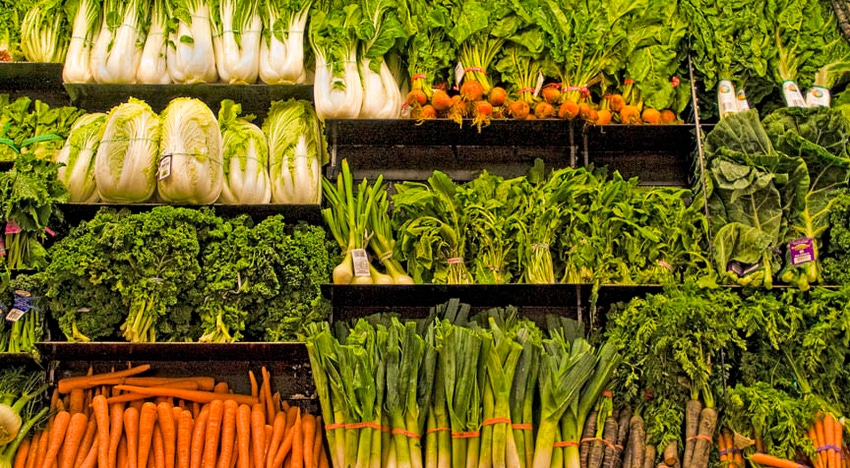January 27, 2014

There’s a trillion dollars riding on the global produce market and Big Ag is moving toward a much larger share, going new school with old school breeding techniques. There’s been no Damascus conversion on the non-GMO and organic road — just recognition of the profits to be made.
Blog archive
Big Data is agriculture’s big blank on the map
Benchmark GM crop contamination case a bitter tale
How to create an epic environmental disaster
Scientific American is running a sharply written story by Ferris Jabr on the marriage of traditional plant breeding with fast and cheap genetic sequencing tools. Jabr describes “… a new generation of plant breeders who combine traditional farming with rapid genetic analysis to create more flavorful, colorful, shapely and nutritious fruits and vegetables. These modern plant breeders are not genetic engineers; in most cases they do not directly manipulate plant DNA in the lab. Rather, they sequence the genomes of many different kinds of plants to build databases that link various versions of genes — known as alleles — to distinct traits. Then, they peek inside juvenile plants to examine the alleles that are already there before choosing which ones to grow in the field and how best to mate one plant with another.”
Agriculture companies, staring down the barrel of economy-sized regulatory costs and a consistent segment of public opposition to GMO technology, are hopping on the marker-assisted breeding bus. The tools for examining DNA sequences aren’t new — but they’re consistently less expensive, faster and more focused. From SciAm: “Marker-assisted breeding is one of the engines pushing breeders to completely rethink their craft. Whereas the major GMOs and most conventionally created crops on the market were designed primarily to benefit farmers, many breeders are now shifting their attention to the consumer.”
For more from Ferris Jabr, see Creating Tastier and Healthier Fruits and Vegetables with a Modern Alternative to GMOs
Wired is running a good piece by Ben Paynter detailing Monsanto’s new produce push: “Frescada lettuce, BellaFina peppers, and Bene-forté broccoli — cheery brand names trademarked to an all-but-anonymous Monsanto subsidiary called Seminis — are rolling out at supermarkets across the U.S. But here’s the twist: The lettuce, peppers, and broccoli … aren’t genetically modified at all. Monsanto created all these veggies using good old-fashioned crossbreeding, the same technology that farmers have been using to optimize crops for millennia.”
Pile of money
It’s GMO-style breeding — with no GMO technology; natural vegetables — produced in a laboratory, with no gene insertion. Wired lists a 4-step generalization of Monsanto’s methods.
1. Identify plants with recognizable, desirable traits.
2. Crossbreed the plants.
3. Sift through the offspring genome for known markers for desirable traits.
4. Grow only the plants with those markers.
The simple 4-step method papers over a high tech approach (backed with billions of research dollars in patience) toward offering consumers premium produce with a new combo of traits. “Figuring out these relationships takes place at a sophisticated sensory and genetics lab perched amid hundreds of acres of experimental farmland in the rural, sun-scorched outskirts of Woodland, a farming town in California’s ag belt.”
For more, see Ben Paynter’s Monsanto Is Going Organic in a Quest for the Perfect Veggie.
No doubt critics will be howling regardless of whether the Monsanto-developed produce lives up to its promise or not. “Nobody has ever tinkered with sugar levels the way Monsanto is attempting; it’s essentially an experiment, says Robert Lustig, a pediatric endocrinologist and president of the Institute for Responsible Nutrition. ‘The only result they care about is profit.’”
Want the latest agricultural news each day? Click here for the Western Farm Press Daily e-mail newsletter.
That’s fair enough to point out; there is indeed a donkey-choking pile of money to be made. But Lustig’s argument has a boilerplate drone and can be cheaply tossed against any agriculture company or product.
The bottom line is whether the new breed of produce lives up to it’s promise in the long term — and that’s a question the market will decide.
*Photo courtesy of Wikipedia
Follow me on Twitter: @CBennett71 or email me: [email protected]
Blog archive
Farm’s Nazi past still fresh for slave workers
Farmer privacy breach brings suit against EPA
James Bond once worked for the EPA
AK-47 rifle was agriculture’s giant loss?
What treasure is buried beneath farmland?
Farmer suicide and the road to agricultural ruin
Gun control and agriculture clash over homemade pistol
Farmland hides mobster for 10 years
What are the greatest agriculture breakthroughs in history?
You May Also Like




